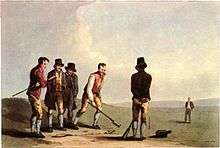Knurr and Spell
Knurr and spell (also called northern spell,[1] nipsy or trap ball) is an old English game, once popular as a pub game.

History
The game originated in the moors of Yorkshire, in England, but then spread throughout the north of England.[2] It can be traced back to the beginning of the 14th century. It was especially popular in the 18th and 19th centuries, but was virtually unknown by the 21st century,[3] though there was a local revival in the 1970s.[4] As late as the 1930s exhibition games of knur and spell by veterans drew large crowds to the Rusland Valley in North Lancashire, according to the chronicles of the North-West Evening Mail, but even then it was regarded as an archaic game.
Etymology
Knurr (from Middle English: knurre, knot) refers to a hardwood or pottery[4] ball, as could be made from a knot of wood. Spell (from Danish: spil, spindle) is the stick of wood used to strike it.[5]
The game around Barnsley was known as "Potty Knocking".[6]
Equipment and play
It is played with a levered wooden trap, by means of which the knurr, about the size of a walnut, is thrown into the air. The knurr is struck by the player with the spell. The object of the game is to hit the knurr the greatest possible distance, either in one or several hits.[5] Each player competes as an individual, without interference, and any number can enter a competition.[2]
The spell is a bat consisting of two parts: a 4 feet (1.2 m) long stick made of ash or lancewood; and a pommel, a piece of very hard wood about 6 inches (150 mm) long, 4 inches (100 mm) wide and 1 inch (25 mm) thick. This was swung in both hands, although shorter bats for one hand were sometimes used.[2][5] A successful hit drives the ball about 200 yards (180 m). The stroke is made by a full swing round the head, not unlike a drive in golf.[2]
Originally the ball was thrown into the air by striking a lever upon which it rested in the trap, but in the later development of the game a trap furnished with a spring was introduced, thus ensuring regularity in the height to which the knurr is tossed, somewhat after the manner of the shooter's clay pigeon. By means of a thumb screw, the player can adjust the spring of the trap according to the velocity of release desired for the ball.[2][5]
On a large moor, and where the game is general, the ground is marked out with wooden pins driven in every 20 yards (18 m). In matches each player supplies their own knurrs and spells and has five rises of the ball to a game.[2]
See also
References
- ↑
 Reynolds, Francis J., ed. (1921). "Knur and Spell". Collier's New Encyclopedia. New York: P.F. Collier & Son Company.
Reynolds, Francis J., ed. (1921). "Knur and Spell". Collier's New Encyclopedia. New York: P.F. Collier & Son Company. - 1 2 3 4 5 6
 Gilman, D. C.; Thurston, H. T.; Colby, F. M., eds. (1905). "Knurr and Spell". New International Encyclopedia (1st ed.). New York: Dodd, Mead.
Gilman, D. C.; Thurston, H. T.; Colby, F. M., eds. (1905). "Knurr and Spell". New International Encyclopedia (1st ed.). New York: Dodd, Mead. - ↑ "Yorkshire game of 'knurr and spell' rediscovered for TV". BBC News. 2011-01-28.
- 1 2 "Knurr and Spell". Countryfile. 2011-01-30. BBC One.
- 1 2 3 4
 This article incorporates text from a publication now in the public domain: Chisholm, Hugh, ed. (1911). "Trap-ball". Encyclopædia Britannica (11th ed.). Cambridge University Press.
This article incorporates text from a publication now in the public domain: Chisholm, Hugh, ed. (1911). "Trap-ball". Encyclopædia Britannica (11th ed.). Cambridge University Press. - ↑ http://www.tradgames.org.uk/games/knur-spell.htm
External links
- OWER BIT BOG OIL (1963-1964) documentary film explaining Knurr and Spell and showing the game being played. (Yorkshire Film Archive Online)
- Knur & Spell, Nipsy etc. - History and Information